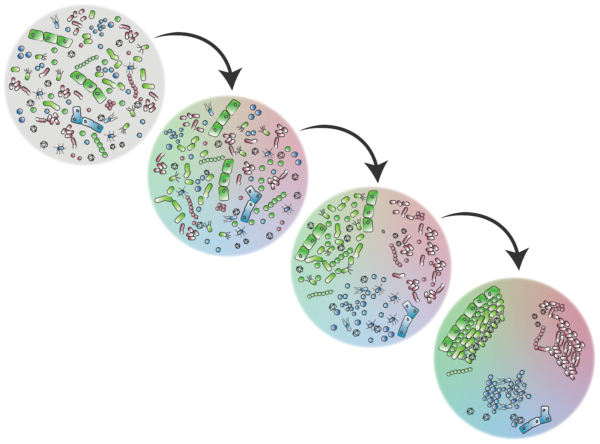Spatiotemporal Control
Spatiotemporal Control considers how to engineer microbiomes for precise, predictable position and function in space and over time.
Spatiotemporal Control considers how to engineer microbiomes for precise, predictable position and function in space and over time.
Engineered microbiomes need to function predictably within space and over time.1Cao, X., Hamilton, J. J., & Venturelli, O. S. (2019). Understanding and Engineering Distributed Biochemical Pathways in Microbial Communities. Biochemistry, 58(2), 94–107. View Publication This requires new technical capabilities that control microbiome composition, architecture, and spread across diverse length and timescales. These scales can range from micrometers in human, animal, and plant applications to kilometers in agricultural and environmental applications, and from short – seconds to minutes – timescales, to years-long evolutionary timescales. In some cases, engineered microbiomes may need to be robust to dispersion forces, environmental changes, and introgression from wild organisms to resist changes in structure or composition. In other cases, microbiomes may need to be capable of evolving along predefined routes to adapt to their environment. Engineered microbiomes may need to undergo programmed succession or spatial reorganization. This theme examines how these parameters will need to be measured, manipulated, and controlled in order to engineer reliable and predictable microbiomes in the lab and natural environments.

Engineering spatial and temporal dynamics of microbiomes. Microbiome engineering will require the ability to stably reorganize communities over time and to direct where and when individual cells or organisms exist within the microbiome. Initial measurements of a natural or randomly distributed microbiome (grey background) will help inform the rational design of a template that is applied to the microbiome (colored background). The template may alter the microbiome genetically, metabolically, or by other means, but will enable microbiome organization over time and space. Additional advances will allow for more detailed patterning that contributes additional functionality, such as enabling the microbiome to alter the environment in which it grows.
While the two goals separate out spatial and temporal engineering, there will necessarily be significant interplay between the two. Spatially engineered microbiomes will be capable of organizing both in response to the environment and through predetermined spatial arrangements. Additionally, microbiomes will be engineered to interact with and influence the environment around them, through processes such as biofilm formation, to create biotic and cell-free structures. Microbiomes must also be engineered to function over time, particularly in cases when a microbiome’s size is not changing or cannot change due to spatial constraints. Engineering microbiomes under such conditions requires understanding the physical, abiotic factors in the environment, as well as tightly regulated mechanisms to control cell growth and death within the microbiome. This, in turn, will help engineer microbiomes that continue to function over long periods of time.